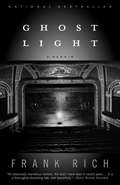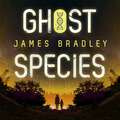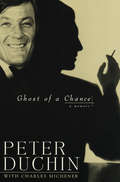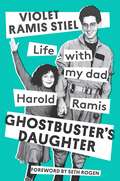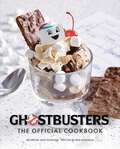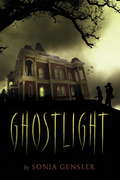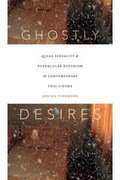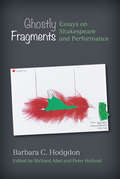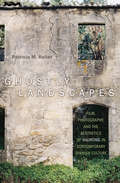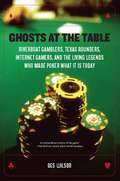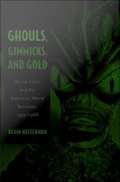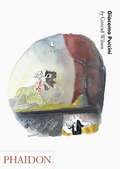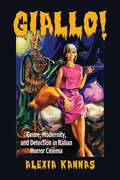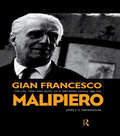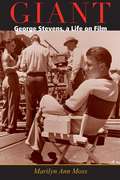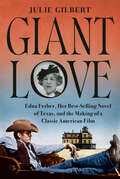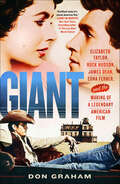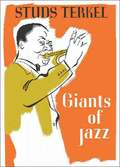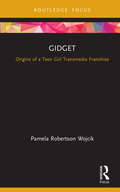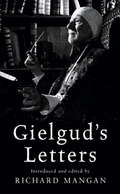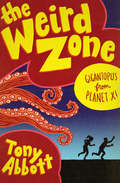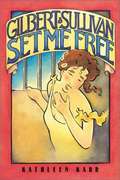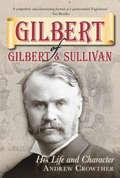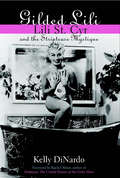- Table View
- List View
Ghost Light
by Frank RichThere is a superstition that if an emptied theater is ever left completely dark, a ghost will take up residence. To prevent this, a single "ghost light" is left burning at center stage after the audience and all of the actors and musicians have gone home. Frank Rich's eloquent and moving boyhood memoir reveals how theater itself became a ghost light and a beacon of security for a child finding his way in a tumultuous world. Rich grew up in the small-townish Washington, D.C., of the 1950s and early '60s, a place where conformity seemed the key to happiness for a young boy who always felt different. When Rich was seven years old, his parents separated--at a time when divorce was still tantamount to scandal--and thereafter he and his younger sister were labeled "children from a broken home." Bouncing from school to school and increasingly lonely, Rich became terrified of the dark and the uncertainty of his future. But there was one thing in his life that made him sublimely happy: the Broadway theater.Rich's parents were avid theatergoers, and in happier times they would listen to the brand-new recordings of South Pacific, Damn Yankees, and The Pajama Game over and over in their living room. When his mother's remarriage brought about turbulent changes, Rich took refuge in these same records, re-creating the shows in his imagination, scene by scene. He started collecting Playbills, studied fanatically the theater listings in The New York Times and Variety, and cut out ads to create his own miniature marquees. He never imagined that one day he would be the Times's chief theater critic.Eventually Rich found a second home at Wash-ington's National Theatre, where as a teenager he was a ticket-taker and was introduced not only to the backstage magic he had dreamed of for so long but to a real-life cast of charismatic and eccentric players who would become his mentors and friends. With humor and eloquence, Rich tells the triumphant story of how the aspirations of a stagestruck young boy became a lifeline, propelling him toward the itinerant family of theater, whose romantic denizens welcomed him into the colorful fringes of Broadway during its last glamorous era.Every once in a while, a grand spectacle comes along that introduces its audiences to characters and scenes that will resound in their memories long after the curtain has gone down. Ghost Light, Frank Rich's beautifully crafted childhood memoir, is just such an event.
Ghost Light: A Memoir
by Frank RichThere is a superstition that if an emptied theater is ever left completely dark, a ghost will take up residence. To prevent this, a single "ghost light" is left burning at center stage after the audience and all of the actors and musicians have gone home. Frank Rich's eloquent and moving boyhood memoir reveals how theater itself became a ghost light and a beacon of security for a child finding his way in a tumultuous world. Rich grew up in the small-townish Washington, D.C., of the 1950s and early '60s, a place where conformity seemed the key to happiness for a young boy who always felt different. When Rich was seven years old, his parents separated--at a time when divorce was still tantamount to scandal--and thereafter he and his younger sister were labeled "children from a broken home." Bouncing from school to school and increasingly lonely, Rich became terrified of the dark and the uncertainty of his future. But there was one thing in his life that made him sublimely happy: the Broadway theater. Rich's parents were avid theatergoers, and in happier times they would listen to the brand-new recordings of South Pacific, Damn Yankees, and The Pajama Game over and over in their living room. When his mother's remarriage brought about turbulent changes, Rich took refuge in these same records, re-creating the shows in his imagination, scene by scene. He started collecting Playbills, studied fanatically the theater listings in The New York Times and Variety, and cut out ads to create his own miniature marquees. He never imagined that one day he would be the Times's chief theater critic. Eventually Rich found a second home at Washington's National Theatre, where as a teenager he was a ticket-taker and was introduced not only to the backstage magic he had dreamed of for so long but to a real-life cast of charismatic and eccentric players who would become his mentors and friends. With humor and eloquence, Rich tells the triumphant story of how the aspirations of a stagestruck young boy became a lifeline, propelling him toward the itinerant family of theater, whose romantic denizens welcomed him into the colorful fringes of Broadway during its last glamorous era. Every once in a while, a grand spectacle comes along that introduces its audiences to characters and scenes that will resound in their memories long after the curtain has gone down. Ghost Light, Frank Rich's beautifully crafted childhood memoir, is just such an event.
Ghost Species: The environmental thriller longlisted for the BSFA Best Novel Award
by James BradleyAs humanity faces the urgency of climate crisis, it is hubris versus hope when Kate Larkin joins a secret project to save the world by resurrecting a ghost species, the Neanderthals. But when the child Eve is born, Kate's role as scientist, and mother, forces her to ask what really makes us, and Eve, human?In an intimate portrayal of high-concept big ideas, can we engineer ourselves out of a problem of our own making? Set against the backdrop of rapidly approaching climate catastrophe, scientists Kate Larkin and Jay Gunesekera are recruited by tech billionaire and mogul Davis Hucken to the forests of Tasmania, Australia. His Foundation's mission is not only halting the effects of climate change, but to re-engineer and reverse the damage through the ambitious process of reviving species lost to the earth over time through natural and unnatural means. Including a clandestine ambition to resurrect the Neanderthals. When Eve, the first child, is born and grows up in a world crumbling around her, questions arise that her and Kate must face. Is she human or not, real or unnatural, and is she the ghost species or are we? As more and more of us are waking up to the truth about our climate, and our need to reverse the damage we have caused, James Bradley's novel is incredibly timely, poignant and reflective on what it means to be human on a personal and a global scale.(P) 2020 Penguin Random House Australia Audio
Ghost of a Chance: A Memoir
by Peter Duchin Charles Michener“The story of [Peter] Duchin’s life has an elegiac aura of glamour and tragedy that might have come directly from the imagination of F. Scott Fitzgerald.”—The Philadelphia Inquirer “This book brings back marvelous memories of a very special time.”—Frank Sinatra Called “a living compendium of a hundred years of social history” by The New York Times Book Review, Peter Duchin has lived through tremendous highs and dismal lows. Orphaned by his glamorous parents, the Newport debutante Marjorie Oelrichs and the famous bandleader Eddy Duchin, he was raised in the privileged, old-money world of Averell Harriman, the diplomat and former governor of New York. He grew up to be one of America’s preeminent bandleaders, effortlessly entertaining and charming partygoers at thousands of society galas, from the White House to Truman Capote’s Black and White Ball. In Ghost of a Chance, he looks back on a life that another man may not have survived. And as he relates the frank, often surprising recollections of the many friends and famous figures who made up the strange family of his youth, Duchin chronicles the changing face of social life in America. Praise for Ghost of a Chance “A tale told with wit and charm . . . It is a sprightly, engaging, and at times hilarious look back at a life spent in music, show business, and what used to be called society.”—The Boston Globe“A bittersweet gem of a book.”—The Philadelphia Inquirer“Peter Duchin’s glamorous story is about absent fathers, surrogate mothers, and dwelling on the edges of money and power in a tuxedoed world.”—Gay Talese“A great read.”—Frank Sinatra
Ghostbuster's Daughter: Life with My Dad, Harold Ramis
by Violet Ramis StielFrom the daughter of comedy legend Harold Ramis (and featuring a Foreword by Seth Rogen) comes a hilarious and heartwarming account of his life, work, and legacy.Most of us know Harold Ramis as the writer, director, and actor who brought warmth and humor to the big screen in classics like Animal House, Caddyshack, Ghostbusters, National Lampoon's Vacation, and Groundhog Day. To his daughter, Violet, he was best known as an amazing father, confidant, and friend. In Ghostbuster's Daughter, Violet reflects on the life and legacy of her father, providing readers with an extraordinarily candid and insightful look into the man who helped shape modern American comedy. Funny, endearing, and vulnerable, Ghostbuster's Daughter takes readers into the private life of the American comedy icon, from his humble roots in Chicago and ascension into Hollywood stardom to his personal philosophies on life, love, and filmmaking. While the book offers a comprehensive history of her father's career, Ghostbuster's Daughter also provides a profound homage to their special father-daughter relationship. Violet weaves anecdotes about her father's unique and devoted parenting style among stories of her own unconventional upbringing, creating a vivid and dynamic portrait of the man behind the movies. A distinctly offbeat memoir as well as a charming family story for the ages, Ghostbuster's Daughter is an intimate look at one of America's preeminent comedy filmmakers.
Ghostbusters: (ghostbusters Film, Original Ghostbusters, Ghostbusters Movie)
by Erik Burnham Jenn FujikawaA Simon & Schuster eBook. Simon & Schuster has a great book for every reader.
Ghostlight
by Sonia GenslerThings that go bump in the night are just the beginning when a summer film project becomes a real-life ghost story! Avery is looking forward to another summer at Grandma's farm, at least until her brother says he's too old for "Kingdom," the imaginary world they'd spent years creating. Lucky for her, there's a new kid staying in the cottage down the road: a city boy with a famous dad, Julian's more than a little full of himself, but he's also a storyteller like Avery. So when he announces his plan to film a ghost story, Avery is eager to join in. Unfortunately, Julian wants to film at Hilliard House, a looming, empty mansion that Grandma has absolutely forbidden her to enter. As terrified as Avery is of Grandma's wrath, the allure of filmmaking is impossible to resist. As the kids explore the secrets of Hilliard house, eerie things begin to happen, and the "imaginary" dangers in their movie threaten to become very real. Have Avery and Julian awakened a menacing presence? Can they turn back before they go too far?
Ghostly Desires: Queer Sexuality and Vernacular Buddhism in Contemporary Thai Cinema
by Arnika FuhrmannThrough an examination of post-1997 Thai cinema and video art Arnika Fuhrmann shows how vernacular Buddhist tenets, stories, and images combine with sexual politics in figuring current struggles over notions of personhood, sexuality, and collective life. The drama, horror, heritage, and experimental art films she analyzes draw on Buddhist-informed conceptions of impermanence and prominently feature the motif of the female ghost. In these films the characters' eroticization in the spheres of loss and death represents an improvisation on the Buddhist disavowal of attachment and highlights under-recognized female and queer desire and persistence. Her feminist and queer readings reveal the entangled relationships between film, sexuality, Buddhist ideas, and the Thai state's regulation of heteronormative sexuality. Fuhrmann thereby provides insights into the configuration of contemporary Thailand while opening up new possibilities for thinking about queer personhood and femininity.
Ghostly Fragments: Essays on Shakespeare and Performance
by Barbara C. HodgdonGhostly Fragments gathers the essays of the late Barbara C. Hodgdon, a renowned scholar of Shakespeare and performance studies. Her influential publications over thirty years reflected a remarkable intelligence, wit, and originality, as did her lectures and conference papers. Richard Abel and Peter Holland have selected essays that represent the wide sweep of Hodgdon’s scholarship, including unpublished pieces and those from hard-to-access sources. The essays reveal a thinker and writer who grows more self-reflective over time, with a distinctive, engaging, often wryly humorous voice that is accessible even to nonspecialist readers. Following a general introduction by Peter Holland, the book’s five subsections (Teaching Shakespeare, Analyzing Stage Performances, Editing Shakespeare Texts, Analyzing Shakespeare Films, and “Shopping” in the Archives) are introduced in turn by scholars Miriam Gilbert, W.B. Worthen, Margaret Jane Kidnie, Richard Abel, and Pascale Aebischer. Collectively, the pieces confirm the originality and élan of Hodgdon’s thinking and writing over time, and reveal her as a natural essayist and stylist, with a distinctive engaging voice. The collection is unique in not only bringing together so much of Hodgdon's work in one place (with an extensive bibliography of her published work) but also in demonstrating how groundbreaking and influential that work has been in the field.
Ghostly Landscapes
by Patricia M. KellerIn Ghostly Landscapes, Patricia M. Keller analyses the aesthetics of haunting and the relationship between ideology and image production by revisiting twentieth-century Spanish history through the camera's lens. Through its vision she demonstrates how the traumatic losses of the Spanish Civil War and their systematic denial and burial during the fascist dictatorship have constituted fertile territory for the expressions of loss, uncanny return, and untimeliness that characterize the aesthetic presence of the ghost.Examining fascist documentary newsreels, countercultural art films from the Spanish New Wave, and conceptual landscape photographs created since the transition to democracy, Keller reveals how haunting serves to mourn loss, redefine space and history, and confirm the significance of lives and stories previously hidden or erased. Her richly illustrated book constitutes a significant reevaluation of fascist and post-fascist Spanish visual culture and a unique theorization of haunting as an aesthetic register inextricably connected to the visual and the landscape.
Ghosts at the Table: Riverboat Gamblers, Texas Rounders, Internet Gamers, and the Living Legends Who Made Poker What It Is Today
by Des WilsonDestined to become "the new poker classic, a must-read" (Mike Sexton, top poker player and promoter), Ghosts at the Table is the game's first definitive history. With verve and wit, internationally renowned poker personality Des Wilson traces poker's Wild West origins in Deadwood, South Dakota-where "Wild" Bill Hickok was said to have been shot holding aces and eights-to the annual World Series of Poker and amazing high-stakes games of modern-day Las Vegas. It's a story full of unforgettable characters-riverboat gamblers, Texas rounders, roadside hucksters, and living legends-who have helped make poker the world's most popular game.
Ghouls, Gimmicks, and Gold: Horror Films and the American Movie Business, 1953-1968
by Kevin HeffernanThe Creature from the Black Lagoon, the Tingler, the Mole People--they stalked and oozed into audiences' minds during the era that followed Boris Karloff's Frankenstein and preceded terrors like Freddy Krueger (A Nightmare on Elm Street) and Chucky (Child's Play). Ghouls, Gimmicks, and Gold pulls off the masks and wipes away the slime to reveal how the monsters that frightened audiences in the 1950s and 1960s--and the movies they crawled and staggered through--reflected fundamental changes in the film industry. Providing the first economic history of the horror film, Kevin Heffernan shows how the production, distribution, and exhibition of horror movies changed as the studio era gave way to the conglomeration of New Hollywood. Heffernan argues that major cultural and economic shifts in the production and reception of horror films began at the time of the 3-d film cycle of 1953-54 and ended with the 1968 adoption of the Motion Picture Association of America's ratings system and the subsequent development of the adult horror movie--epitomized by Rosemary's Baby. He describes how this period presented a number of daunting challenges for movie exhibitors: the high costs of technological upgrade, competition with television, declining movie attendance, and a diminishing number of annual releases from the major movie studios. He explains that the production and distribution branches of the movie industry responded to these trends by cultivating a youth audience, co-producing features with the film industries of Europe and Asia, selling films to television, and intensifying representations of sex and violence. Shining through Ghouls, Gimmicks, and Gold is the delight of the true horror movie buff, the fan thrilled to find The Brain that Wouldn't Die on television at 3 am.
Giacomo Puccini
by Conrad WilsonGiacomo Puccini (1858--1924), composer of such popular operas as La Bohème and Madame Butterfly, is most renowned for his gift as a melodist. With his final opera, Turandot, Puccini composed the last Italian work in the genre to hold a firm place in the international repertoire. The author draws attention to the felicity, daring and extraordinary colouring of his music, countering the view held during Puccini's lifetime that he was a retrogressive who aimed to shock. Puccini is shown to have been a new force in musical drama, and yet a man who remained insecure about his creative powers. Conrad Wilson's book is a polemical, passionate and rational attempt to set the man from Lucca among the immortal greats.
Giallo!: Genre, Modernity, and Detection in Italian Horror Cinema (SUNY series, Horizons of Cinema)
by Alexia KannasItalian giallo films have a peculiar allure. Taking their name from the Italian for "yellow"— reflecting the covers of pulp crime novels—these genre movies were principally produced between 1960 and the late 1970s. These cinematic hybrids of crime, horror, and detection are characterized by elaborate set-piece murders, lurid aesthetics, and experimental soundtracks. Using critical frameworks drawn from genre theory, reception studies, and cultural studies, Giallo! traces this historically marginalized genre's journey from Italian cinemas to the global cult-film canon. Through close textual analysis of films including The Girl Who Knew Too Much (1963), Blood and Black Lace (1964), The Bird with the Crystal Plumage (1970), The Black Belly of the Tarantula (1971), and The Case of the Bloody Iris (1972), Alexia Kannas considers the rendering of urban space in the giallo and how it expresses a complex and unsettling critique of late modernity.
Gian Francesco Malipiero: The Life, Times and Music of a Wayward Genius (Contemporary Music Studies #Vol. 17)
by John C. WaterhouseIn recent years Gian Francesco Malipiero has been recognised increasingly widely as one of the most original and strangely fascinating Italian composers of the early 20th century. He was the teacher of Maderna and Nono, and was revered by (among many others) Dallapiccola, who even called him the most important (musical) personality that Italy has had since the death of Verdi . He was also a key figure in the revival of the long- neglected music of Italy's great past, and himself edited what remains the only virtually complete edition of the surviving compositions of Monteverdi. The present book not only provides the first monographic survey of Malipiero's life, times and music to appear in English, but covers the subject more comprehensively than any previous publication in any language. Dr Waterhouse draws on hitherto unpublished documents, and with the help of numerous musical examples, analyses the composer's works, style and idiosyncratic personality.
Giant
by Marilyn Ann MossMarilyn Mosss Giant examines the life of one of the most influential directors to work in Hollywood from the 1930s to the 1960s. George Stevens directed such popular and significant films as Shane, Giant, A Place in the Sun, and The Diary of Anne Frank.
Giant Love: Edna Ferber, Her Best-selling Novel of Texas, and the Making of a Classic American Film
by Julie GilbertTHE NEW YORK TIMES BOOK REVIEW EDITORS' CHOICE • A book that explores the great American novelist and playwright Edna Ferber, winner of the Pulitzer Prize for Ficton, whose work was made into many Academy Award-winning movies; the writing of her controversial, international best-selling novel about Texas, and the making of George Stevens&’ Academy Award winning epic film of the same name, Giant.The stupendous publication of Edna Ferber's Giant in 1952 set off a storm of protest over the novel's portrayal of Texas manners, money and mores with oil-rich Texans threatening to shoot, lynch or ban Ferber from ever entering the state again.In Giant Love, Julie Gilbert writes of the internationally best-selling Ferber, one of the most widely read writers in the first half of the 20th Century – her evolution from mid-west maverick girl-reporter to Pulitzer Prize winning, beloved American novelist, from her want-to-be actress days to becoming Broadway's acclaimed prize-winning playwright whose collaborators – George S. Kauffman and Moss Hart, among them, were, along with Ferber, herself, the most successful playwrights of their time.Here is the making of an American classic novel and the film that followed in its wake. We see how George Stevens, Academy-Award winning director, wooed the prickly, stubborn Ferber, ultimately getting her to agree to everything including writing, for the first time ever, a draft of a screenplay, to her okaying James Dean for the part of the ranch hand, Jett Rink, something she was dead set against.Here is the casting of Elizabeth Taylor, Rock Hudson, James Dean and their backstory triangle of sex and seduction – each becoming a huge star because of the film; the frustrated Stevens trying to direct the instinctive but undisciplined Dean, and the months long landmark filming in the sleepy town of Marfa, Texas, suddenly invaded by a battalion of a film crew and some of the biggest stars in the rising celebrity culture.
Giant: Elizabeth Taylor, Rock Hudson, James Dean, Edna Ferber, and the Making of a Legendary American Film
by Don GrahamA larger-than-life narrative of the making of the classic film, marking the rise of America as a superpower, the ascent of Hollywood celebrity, and the flowering of Texas culture as mythology.Featuring James Dean, Rock Hudson, and Elizabeth Taylor, Giant is an epic film of fame and materialism, based around the discovery of oil at Spindletop and the establishment of the King Ranch of south Texas. Isolating his star cast in the wilds of West Texas, director George Stevens brought together a volatile mix of egos, insecurities, sexual proclivities, and talent. Stevens knew he was overwhelmed with Hudson’s promiscuity, Taylor’s high diva-dom, and Dean’s egotistical eccentricity. Yet he coaxed performances out of them that made cinematic history, winning Stevens the Academy Award for Best Director and garnering nine other nominations, including a nomination for Best Actor for James Dean, who died before the film was finished. In this compelling and impeccably researched narrative history of the making of the film, Don Graham chronicles the stories of Stevens, whose trauma in World War II intensified his ambition to make films that would tell the story of America; Edna Ferber, a considerable literary celebrity, who meets her match in the imposing Robert Kleberg, proprietor of the vast King Ranch; and Glenn McCarthy, an American oil tycoon; and Errol Flynn lookalike with a taste for Hollywood. Drawing on archival sources Graham’s Giant is a comprehensive depiction of the film’s production showing readers how reality became fiction and fiction became cinema.
Giants of Jazz (Revised and Updated)
by Studs Terkel Milly Hawk DanielReissued with the original illustrations and discography, Giants of Jazz offers a unique glimpse into the lives of America's jazz greats. Told with masterful detail, the selected portraits weave together the stories of the individual jazz musicians' lives with the history of the jazz era, and jazz music's evolution from the speakeasies of New York to the concert halls of the world's greatest cities. Details include Joe Oliver's favorite meal, Fats Waller's 1932 rendezvous in Paris with eminent organist Marcel Dupre, Dizzy Gillespie's trip as a child to the pawnshop to buy his first horn, and the origin of Billie Holiday's nickname. Other artists featured include Count Basie, Bix Beiderbecke, Benny Goodman, Woody Herman, and Bessie Smith.
Gidget: Origins of a Teen Girl Transmedia Franchise (Cinema and Youth Cultures)
by Pamela Robertson WojcikGidget: Origins of a Teen Girl Transmedia Franchise examines the multiplicity of books, films, TV shows, and merchandise that make up the transmedia Gidget universe from the late 1950s to the 1980s. The book examines the Gidget phenomenon as an early and unique teen girl franchise that expands understanding of both teen girlhood and transmedia storytelling. It locates the film as existing at the historical intersection of numerous discourses and events, including the emergence of surf culture and surf films; the rise of California as signifier of modernity and as the epicentre of white American middle-class teen culture; the annexation of Hawaii; the invention of Barbie; and Hollywood’s reluctant acceptance of teen culture and teen audiences. Each chapter places the Gidget text in context, looking at production and reception circumstances and intertexts such as the novels of Françoise Sagan, the Tammy series, La Dolce Vita, and The Patty Duke Show, to better understand Gidget’s meaning at different points in time. This book explores many aspects of Gidget, providing an invaluable insight into this iconic franchise for students and researchers in film studies, feminist media studies, and youth culture.
Gielgud's Letters
by John Gielgud'In this comprehensive volume, we see the actor in a range of roles: loving son, wicked gossip, star actor, indecisive director, anguished lover, brilliant anecdotist. This splendid book reveals an infinitely complicated and attractive character. We may not look upon his like again' Jonathan Croall, SpectatorThe above quotes sums it up - this astonishing collection of letters brings us up close to one of the foremost, and best loved, actors of this century. John Gielgud wrote letters almost every day of his adult life. Whether at home in London or abroad, he delighted in recounting what he felt about events around him. Here for the first time - and not previously available to biographers - are Gielgud's love letters. They show that he was not shy is expressing the intimacies of personal relationships. He also loved gossip and writes about his contemporaries, including the great actors of period: Olivier, Richardson, Redgrave, Peggy Ashcroft, Edith Evans and the like. A revealing account but also a hugely warm and compelling insight into a man of many sides.
Gigantopus from Planet X! (The Weird Zone #6)
by Tony AbbottHumongous Studios makes the weirdest horror movies ever, and in its next film, the monster is a real-life threat! Sean and Holly&’s dad owns the wackiest business in Grover&’s Mill: a horror filmmaking studio. For his newest movie, their dad has decided to feature a gigantic robot octopus as the star of the show. When Holly and Sean visit the studio with their friends, they are excited to get a first-hand look at how movies are made. Unfortunately, there is one problem: Gigantopus is completely out of control, and its alien master plans to use the star to take Grover&’s Mill back to her home planet!In a fight fit for the big screen, Holly and Sean must battle Gigantopus and save their town from being sucked into space. This may turn out to be their dad&’s oddest movie yet!
Gilbert and Sullivan Set Me Free
by Kathleen KarrIn prison, there are few secrets. But Libby Dodge, the youngest inmate, guards the nature of her crime from the other women, even as they openly recount their former lives as arsonists, thieves, and prostitutes.
Gilbert of Gilbert and Sullivan: His Life and Character
by Andrew CrowtherThe author of The Pirates of Penzance, The Mikado, HMS Pinafore and the other great Savoy libretti, W S Gilbert, witty, caustic and disrespectful, was one of the celebrities of the late Victorian age. In his time he had been many things: journalist, theatre critic, cartoonist, comic poet, stage director, writer of short stories, dramatist. A political satire he wrote was banned by the Lord Chamberlain at the personal insistence of the Prince of Wales. He wrote the most brilliantly inventive plays of his time. With Arthur Sullivan he wrote comic operas that defined the age. He became richer and more famous than he could have imagined, but at the price of his artistic freedom. This is the story of an angry and quarrelsome man, discontented with himself and the age he lived in, raging at life’s absurdities and laughing at them. In this book his glorious, contradictory character is explored and brought vividly to life.
Gilded Lili
by Kelly DinardoBlond and beautiful, Lili St. Cyr shimmied across the country's nightclubs as one of the century's great sirens. She inspired future femme fatales including Marilyn Monroe, Madonna and Dita Von Teese. She helped cultivate the modern-day impression of striptease. And, with stage routines featuring themes from fantasy, history and literature, she scandalized and seduced millions, influencing pop culture for decades.Gilded Lili: Lili St. Cyr and the Striptease Mystique explores the life of the last real queen of burlesque. Born into a poor family, abandoned by her parents, and raised by her grandmother, she used her ambition, beauty, and charm to escape her small-town life. Upon becoming the top burlesque dancer of her era, she amassed legions of famous fans, including Betty Grable, Frank Sinatra, Ronald Reagan, and Humphrey Bogart. During her reign, one reporter called her "the rich man's Gypsy Rose Lee" and Marilyn Monroe took cues from her acts. After she retired, Mike Wallace wrote that his television interview with her remained one of the most fascinating he had ever conducted.The private Lili was considerably more troubled, however. Despite being married six times, Lili found love elusive; she was involved in affairs with wealthy businessmen and rumored to have dalliances with celebrities including Orson Welles, Victor Mature and Yul Brynner. She had as many as ten abortions, attempted suicide several times, and became reliant on sleeping pills and, ultimately, heroin.A searing look at American sexuality in the twentieth century, Gilded Lili immortalizes the legend with verve and grace. Lili's era - which see-sawed between McCarthyism and puritanical humor - is presented with vibrancy, intelligence, and commentary on the ever-changing dynamics between sex and commerce. Based on exhaustive research and filled with rare photographs, Gilded Lili reveals a portrait of a woman who made the century sizzle.
